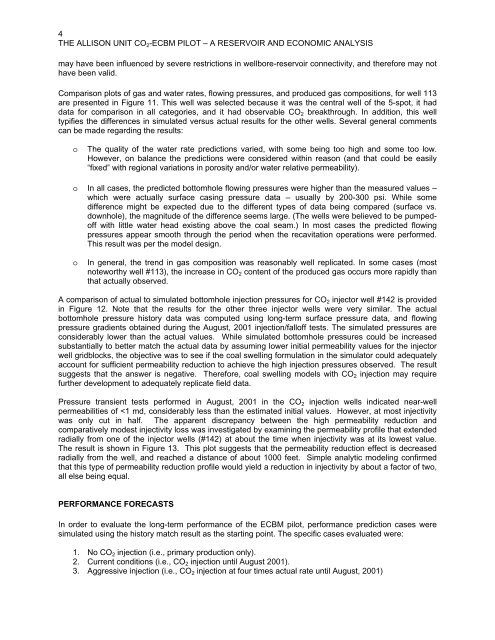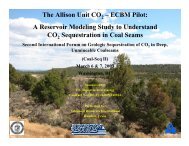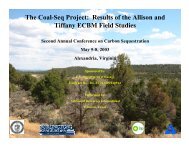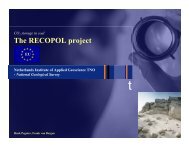The Allison Unit CO2-ECBM Pilot - A Reservoir and ... - Coal-Seq
The Allison Unit CO2-ECBM Pilot - A Reservoir and ... - Coal-Seq
The Allison Unit CO2-ECBM Pilot - A Reservoir and ... - Coal-Seq
Create successful ePaper yourself
Turn your PDF publications into a flip-book with our unique Google optimized e-Paper software.
4<br />
THE ALLISON UNIT CO 2 -<strong>ECBM</strong> PILOT – A RESERVOIR AND ECONOMIC ANALYSIS<br />
may have been influenced by severe restrictions in wellbore-reservoir connectivity, <strong>and</strong> therefore may not<br />
have been valid.<br />
Comparison plots of gas <strong>and</strong> water rates, flowing pressures, <strong>and</strong> produced gas compositions, for well 113<br />
are presented in Figure 11. This well was selected because it was the central well of the 5-spot, it had<br />
data for comparison in all categories, <strong>and</strong> it had observable CO 2 breakthrough. In addition, this well<br />
typifies the differences in simulated versus actual results for the other wells. Several general comments<br />
can be made regarding the results:<br />
o<br />
<strong>The</strong> quality of the water rate predictions varied, with some being too high <strong>and</strong> some too low.<br />
However, on balance the predictions were considered within reason (<strong>and</strong> that could be easily<br />
“fixed” with regional variations in porosity <strong>and</strong>/or water relative permeability).<br />
o In all cases, the predicted bottomhole flowing pressures were higher than the measured values –<br />
which were actually surface casing pressure data – usually by 200-300 psi. While some<br />
difference might be expected due to the different types of data being compared (surface vs.<br />
downhole), the magnitude of the difference seems large. (<strong>The</strong> wells were believed to be pumpedoff<br />
with little water head existing above the coal seam.) In most cases the predicted flowing<br />
pressures appear smooth through the period when the recavitation operations were performed.<br />
This result was per the model design.<br />
o<br />
In general, the trend in gas composition was reasonably well replicated. In some cases (most<br />
noteworthy well #113), the increase in CO 2 content of the produced gas occurs more rapidly than<br />
that actually observed.<br />
A comparison of actual to simulated bottomhole injection pressures for CO 2 injector well #142 is provided<br />
in Figure 12. Note that the results for the other three injector wells were very similar. <strong>The</strong> actual<br />
bottomhole pressure history data was computed using long-term surface pressure data, <strong>and</strong> flowing<br />
pressure gradients obtained during the August, 2001 injection/falloff tests. <strong>The</strong> simulated pressures are<br />
considerably lower than the actual values. While simulated bottomhole pressures could be increased<br />
substantially to better match the actual data by assuming lower initial permeability values for the injector<br />
well gridblocks, the objective was to see if the coal swelling formulation in the simulator could adequately<br />
account for sufficient permeability reduction to achieve the high injection pressures observed. <strong>The</strong> result<br />
suggests that the answer is negative. <strong>The</strong>refore, coal swelling models with CO 2 injection may require<br />
further development to adequately replicate field data.<br />
Pressure transient tests performed in August, 2001 in the CO 2 injection wells indicated near-well<br />
permeabilities of








